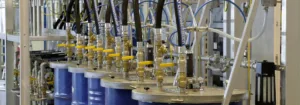Updated: August 2025
Introduction
Air motors, also known as pneumatic motors, play a critical role in industries where safety, reliability, and compactness are essential. Powered by compressed air, these motors deliver high power-to-weight ratios and can safely operate in explosive or hazardous environments. But not all air motors are the same—each type offers unique advantages and limitations.
This guide compares vane, piston, gear, and turbine air motors in detail. We’ll examine how they work, their performance characteristics, applications, and how to choose the right motor for your needs.
Key Selection Criteria for Air Motors
Before diving into motor types, it’s essential to understand the factors that determine the right choice:
Torque & Speed Requirements: Match motor output with load conditions.
Operating Environment: Consider ATEX zones, hygienic requirements, corrosive atmospheres.
Size & Weight Constraints: Compactness matters in handheld tools and robotics.
Air Supply: Adequate pressure and flow rate are critical.
Efficiency & Energy Use: Impacts operating costs.
Maintenance Needs: Lubrication, vane wear, or piston service intervals.
Control Requirements: Precision in speed or reversible rotation.
Reliability & Safety: Especially in hazardous industries.
Types of Air Motors
1. Vane Air Motors
How they work: A rotor with sliding vanes spins inside an off-center chamber. Compressed air pushes the vanes outward, creating rotary motion.
Performance:
Speed range: 100–25,000 rpm
Moderate torque
Efficiency: ~20–30%
Requires lubrication for optimal life
Pros:
Compact and lightweight
Simple design, low cost
Can operate in ATEX zones
Widely used in handheld tools
Cons:
Lower torque at low speeds compared to piston motors
Noise at high rpm
Wear of vanes over time
Applications: Drills, grinders, mixers, conveyors, food & chemical industry tools.
2. Piston Air Motors
How they work: Pistons are driven by compressed air, converting reciprocating motion into rotation. Can be axial or radial designs.
Performance:
High starting torque
Smooth control, ideal for low-speed applications
Efficiency: ~10–40%
More complex and larger than vane motors
Pros:
Excellent torque at low speeds
Reliable in harsh conditions
Smooth operation under heavy loads
Cons:
Heavier and bulkier than vane motors
Higher cost
Vibration in some configurations
Applications: Mining, hoisting, conveyors, chemical plants, heavy-duty tools.
3. Radial Piston Motors (Variant)
Performance:
Very high starting torque
Robust and durable
Larger footprint and higher cost
Applications: Continuous-duty heavy industrial operations, winches, and lifting equipment.
4. Gear Air Motors
How they work: Torque is generated by compressed air moving through a gear mechanism.
Performance:
Compact and robust
Moderate torque
Limited speed control
Pros:
Simple and reliable
Lower maintenance than vane motors
Cons:
Noisy
Narrow application range
Applications: Compact drives, where reliability matters more than speed control.
5. Turbine Air Motors
How they work: Compressed air drives a turbine wheel, producing high-speed rotation.
Performance:
Very high speeds
Smooth, low-vibration operation
Efficiency: 65–75%
Pros:
High efficiency compared to other air motor types
Lightweight
Low maintenance
Cons:
Low starting torque
Sensitive to air quality
Applications: Dental drills, aircraft starters, high-speed spindles, continuous high-RPM applications.
Performance Insights & Comparison Table
Air motors have unique torque-speed characteristics. Power typically peaks at about 50% of the free speed, while stall torque can be about twice the maximum torque at working speed. Air consumption is highest at free speed and decreases under load, though leakage still causes some consumption at stall.
| Motor Type | Strengths | Limitations | Typical Applications |
|---|---|---|---|
| Vane | Compact, low cost, versatile | Lower torque at low speeds | Tools, mixers, conveyors |
| Piston | High torque, reliable, robust | Bulkier, costlier | Hoists, mining, heavy machinery |
| Radial Piston | Very high starting torque | Large, expensive | Winches, continuous heavy duty |
| Gear | Compact, reliable, low maintenance | Noisy, limited speed control | Simple drives, automation |
| Turbine | High efficiency, high speed | Low torque, air-sensitive | Dental drills, spindles, turbines |
Advantages of Air Motors vs Electric Motors
Safety: Spark-free, safe in explosive zones (ATEX-certified).
Power-to-Weight Ratio: 2–3× lighter than electric motors for same output.
Cooling & Overload Resistance: Self-cooling, can stall without damage.
Rugged Reliability: Operates in vibration, temperature extremes, humidity.
Flexibility: Easy to vary speed and direction using air supply control.
Lower Downtime: Simplified maintenance.
Limitations & Considerations
Efficiency: Lower than electric motors; compressed air is costly to generate.
Noise: Especially at high speeds.
Air Quality Requirements: Needs dry, filtered air.
Environmental Impact: Compressed air systems can consume significant energy.
Choosing the Right Motor – Decision Guide
When selecting an air motor:
Match torque and speed using performance curves.
Assess environmental needs: ATEX, hygienic, temperature range.
Check air supply capacity and stability.
Consider lifecycle cost: efficiency, maintenance, downtime.
Use application mapping:
Food & Pharma: Lubrication-free vane motors.
Hazardous Zones: ATEX-certified vane or piston motors.
Heavy Loads: Radial piston motors.
High-Speed Precision: Turbine motors.
Compact Drives: Gear motors.
Air Motor Types Compared FAQ
Turbine air motors, with efficiencies up to 75%.
By regulating air pressure, flow, or using control valves.
Yes, some vane motors are designed for lubrication-free operation.
Yes, especially vane and gear motors at high speeds.
Electric motors are generally more efficient, but air motors win in safety, weight, and resilience.
Conclusion & Next Steps
Air motors offer unique benefits in safety, flexibility, and reliability that make them indispensable in many industries. The right choice depends on matching torque, speed, and environmental needs with the appropriate motor type.


